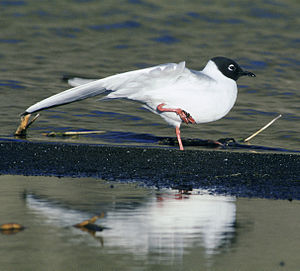Bonaparte gull
| Bonaparte gull | ||||||||||||
|---|---|---|---|---|---|---|---|---|---|---|---|---|

Bonaparte gull in splendid dress |
||||||||||||
| Systematics | ||||||||||||
|
||||||||||||
| Scientific name | ||||||||||||
| Chroicocephalus philadelphia | ||||||||||||
| ( Ord , 1815) |

The Bonaparte gull ( Chroicocephalus philadelphia , syn .: Larus philadelphia ) is a monotypic gull species . It is a nearctic species that is very similar to the black-headed gull , but is slightly smaller. The Bonaparte gull is named in honor of the French natural scientist Charles Lucien Bonaparte , a nephew of Napoleon Bonaparte .
The IUCN classifies the Bonaparte gull as harmless ( least concern ) and estimates the worldwide population at 260,000 to 530,000 sexually mature individuals.
Appearance
The Bonaparte gull reaches a body length of 28 to 30 centimeters. The wingspan is 90 to 100 centimeters. The weight varies between 180 and 230 grams.
In its splendid dress, the Bonaparte gull has a dark gray or black head. The black color extends from the upper neck to the chin. The beak is black, the inside of the beak is bright orange-red. It has a very thin dark red eye ring, the iris is dark brown. There are two white crescent-shaped spots above and below the eye. The upper side of the body and the tail are white, the chest and belly appear washed over pink in some individuals. The top of the body is blue-gray, the outer hand wings have black tips. The legs are red.
The dark head cap is missing in the simple dress. Bonaparte gulls only have a black, mostly crescent-shaped spot at the ear level. Another, very small, dark gray spot can be found in front of the eye. The top of the head looks dirty gray. The legs are pink in the resting dress.
Fledglings also have a dark ear mark, the top of the head and the nape of the neck are washed out with a dirty brownish tinge. The top of the body is pale gray-brown. The downy chicks are spotted black and brown.
In the distribution area there is only one possibility of confusion with the swallow gull . However, this one has a forked tail.
Distribution area
The Bonaparte gull breeds in southern Alaska, but it is rare on both the western and northern coasts. It is also a breeding bird of the Yukon Territory and occurs from there to the southern border of Hudson Bay . Their habitat are lakes within the forest belt.
The Bonaparte gull is a migratory bird and migrates to the east and west coasts of the United States during the winter months. It also winters at the Great Lakes .
Way of life
Breeding Bonaparte gulls mainly eat insects, which they catch in flight and also peck from the ground or the surface of the water. In the winter half-year fish and crustaceans play a larger role in the food spectrum. Bonaparte gulls are very sociable birds during this period.
They usually breed singly, but small breeding colonies are occasionally found. According to the current state of knowledge, they enter into a monogamous seasonal marriage. They build their nests in trees, which is very unusual for seagulls. The nest consists of small branches and is covered with moss and grass. They occasionally use nests from the previous year, which they then expand further.
The clutch usually consists of three eggs. These are reddish-brown-olive in color or gray-brownish with brown spots. The breeding season is 22 to 25 days. Both parent birds are involved in the brood. The young birds are fledged at around 35 days of age. Bonaparte gulls breed for the first time at the age of two years at the earliest.
supporting documents
literature
- Richard Sale: A Complete Guide to Arctic Wildlife , published by Christopher Helm, London 2006, ISBN 0-7136-7039-8
Web links
- BirdLife factsheet about the Bonaparte Gull
- Larus Philadelphia inthe IUCN 2013 Red List of Threatened Species . Listed by: BirdLife International, 2012. Retrieved January 14, 2014.
Single receipts
- ↑ BirdLife Factsheet , accessed December 19, 2010
- ↑ Sale, p. 241
- ↑ Sale, p. 241
- ↑ Sale, p. 241

